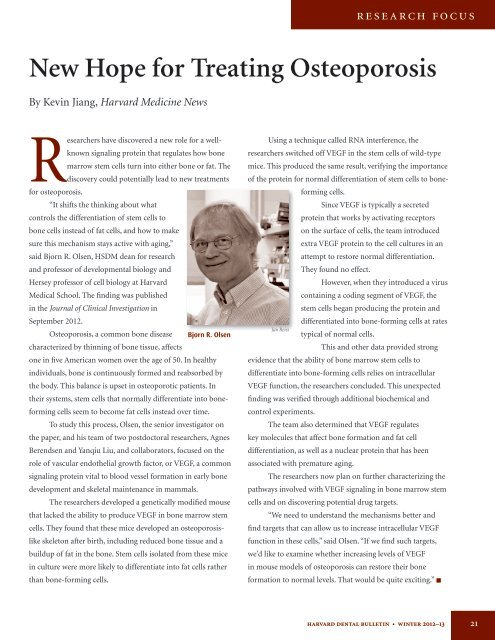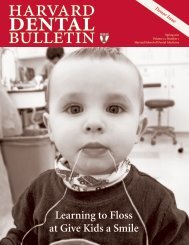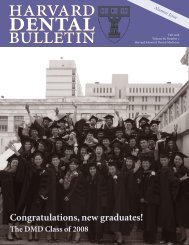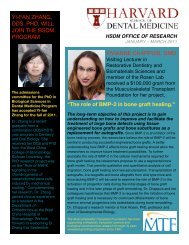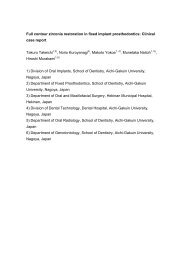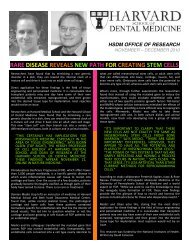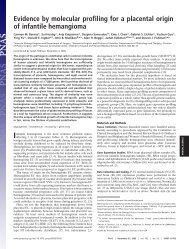Public Health Issue - Harvard School of Dental Medicine
Public Health Issue - Harvard School of Dental Medicine
Public Health Issue - Harvard School of Dental Medicine
- No tags were found...
You also want an ePaper? Increase the reach of your titles
YUMPU automatically turns print PDFs into web optimized ePapers that Google loves.
esearch focusNew Hope for Treating OsteoporosisBy Kevin Jiang, <strong>Harvard</strong> <strong>Medicine</strong> NewsResearchers have discovered a new role for a wellknownsignaling protein that regulates how bonemarrow stem cells turn into either bone or fat. Thediscovery could potentially lead to new treatmentsfor osteoporosis.“It shifts the thinking about whatcontrols the differentiation <strong>of</strong> stem cells tobone cells instead <strong>of</strong> fat cells, and how to makesure this mechanism stays active with aging,”said Bjorn R. Olsen, HSDM dean for researchand pr<strong>of</strong>essor <strong>of</strong> developmental biology andHersey pr<strong>of</strong>essor <strong>of</strong> cell biology at <strong>Harvard</strong>Medical <strong>School</strong>. The finding was publishedin the Journal <strong>of</strong> Clinical Investigation inSeptember 2012.Osteoporosis, a common bone disease Bjorn R. Olsencharacterized by thinning <strong>of</strong> bone tissue, affectsone in five American women over the age <strong>of</strong> 50. In healthyindividuals, bone is continuously formed and reabsorbed bythe body. This balance is upset in osteoporotic patients. Intheir systems, stem cells that normally differentiate into boneformingcells seem to become fat cells instead over time.To study this process, Olsen, the senior investigator onthe paper, and his team <strong>of</strong> two postdoctoral researchers, AgnesBerendsen and Yanqiu Liu, and collaborators, focused on therole <strong>of</strong> vascular endothelial growth factor, or VEGF, a commonsignaling protein vital to blood vessel formation in early bonedevelopment and skeletal maintenance in mammals.The researchers developed a genetically modified mousethat lacked the ability to produce VEGF in bone marrow stemcells. They found that these mice developed an osteoporosislikeskeleton after birth, including reduced bone tissue and abuildup <strong>of</strong> fat in the bone. Stem cells isolated from these micein culture were more likely to differentiate into fat cells ratherthan bone-forming cells.Using a technique called RNA interference, theresearchers switched <strong>of</strong>f VEGF in the stem cells <strong>of</strong> wild-typemice. This produced the same result, verifying the importance<strong>of</strong> the protein for normal differentiation <strong>of</strong> stem cells to boneformingcells.Since VEGF is typically a secretedprotein that works by activating receptorson the surface <strong>of</strong> cells, the team introducedextra VEGF protein to the cell cultures in anattempt to restore normal differentiation.They found no effect.However, when they introduced a viruscontaining a coding segment <strong>of</strong> VEGF, thestem cells began producing the protein anddifferentiated into bone-forming cells at ratesJan Reisstypical <strong>of</strong> normal cells.This and other data provided strongevidence that the ability <strong>of</strong> bone marrow stem cells todifferentiate into bone-forming cells relies on intracellularVEGF function, the researchers concluded. This unexpectedfinding was verified through additional biochemical andcontrol experiments.The team also determined that VEGF regulateskey molecules that affect bone formation and fat celldifferentiation, as well as a nuclear protein that has beenassociated with premature aging.The researchers now plan on further characterizing thepathways involved with VEGF signaling in bone marrow stemcells and on discovering potential drug targets.“We need to understand the mechanisms better andfind targets that can allow us to increase intracellular VEGFfunction in these cells,” said Olsen. “If we find such targets,we’d like to examine whether increasing levels <strong>of</strong> VEGFin mouse models <strong>of</strong> osteoporosis can restore their boneformation to normal levels. That would be quite exciting.” •harvard dental bulletin • winter 2012–1321


